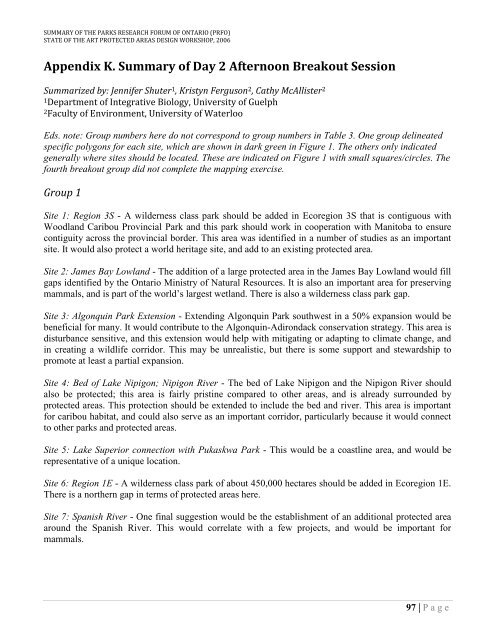Top-Down vs. Bottom Up: Working Towards Consensus ... - CASIOPA
Top-Down vs. Bottom Up: Working Towards Consensus ... - CASIOPA
Top-Down vs. Bottom Up: Working Towards Consensus ... - CASIOPA
- No tags were found...
You also want an ePaper? Increase the reach of your titles
YUMPU automatically turns print PDFs into web optimized ePapers that Google loves.
SUMMARY OF THE PARKS RESEARCH FORUM OF ONTARIO (PRFO)STATE OF THE ART PROTECTED AREAS DESIGN WORKSHOP, 2006Appendix K. Summary of Day 2 Afternoon Breakout SessionSummarized by: Jennifer Shuter 1 , Kristyn Ferguson 2 , Cathy McAllister 21 Department of Integrative Biology, University of Guelph2 Faculty of Environment, University of WaterlooEds. note: Group numbers here do not correspond to group numbers in Table 3. One group delineatedspecific polygons for each site, which are shown in dark green in Figure 1. The others only indicatedgenerally where sites should be located. These are indicated on Figure 1 with small squares/circles. Thefourth breakout group did not complete the mapping exercise.Group 1Site 1: Region 3S - A wilderness class park should be added in Ecoregion 3S that is contiguous withWoodland Caribou Provincial Park and this park should work in cooperation with Manitoba to ensurecontiguity across the provincial border. This area was identified in a number of studies as an importantsite. It would also protect a world heritage site, and add to an existing protected area.Site 2: James Bay Lowland - The addition of a large protected area in the James Bay Lowland would fillgaps identified by the Ontario Ministry of Natural Resources. It is also an important area for preservingmammals, and is part of the world‟s largest wetland. There is also a wilderness class park gap.Site 3: Algonquin Park Extension - Extending Algonquin Park southwest in a 50% expansion would bebeneficial for many. It would contribute to the Algonquin-Adirondack conservation strategy. This area isdisturbance sensitive, and this extension would help with mitigating or adapting to climate change, andin creating a wildlife corridor. This may be unrealistic, but there is some support and stewardship topromote at least a partial expansion.Site 4: Bed of Lake Nipigon; Nipigon River - The bed of Lake Nipigon and the Nipigon River shouldalso be protected; this area is fairly pristine compared to other areas, and is already surrounded byprotected areas. This protection should be extended to include the bed and river. This area is importantfor caribou habitat, and could also serve as an important corridor, particularly because it would connectto other parks and protected areas.Site 5: Lake Superior connection with Pukaskwa Park - This would be a coastline area, and would berepresentative of a unique location.Site 6: Region 1E - A wilderness class park of about 450,000 hectares should be added in Ecoregion 1E.There is a northern gap in terms of protected areas here.Site 7: Spanish River - One final suggestion would be the establishment of an additional protected areaaround the Spanish River. This would correlate with a few projects, and would be important formammals.97 | P a g e


